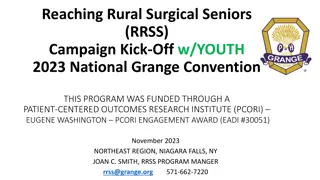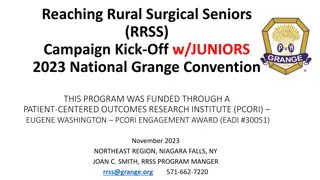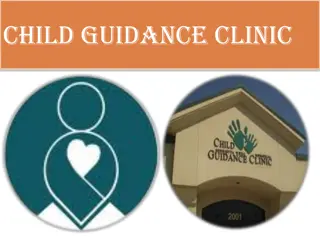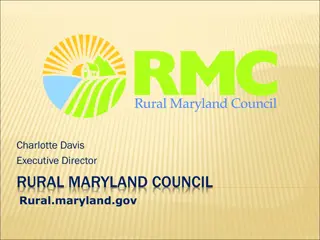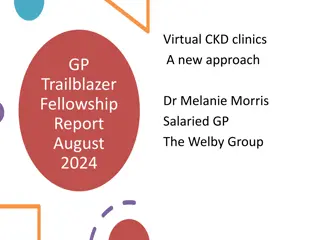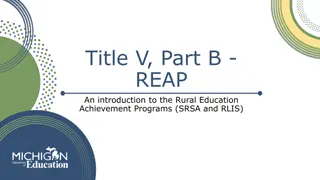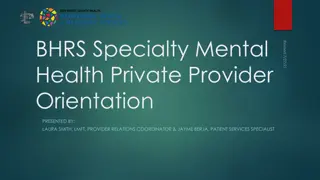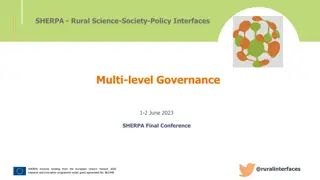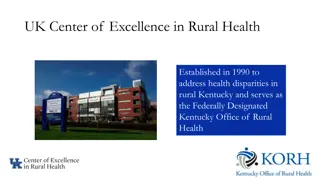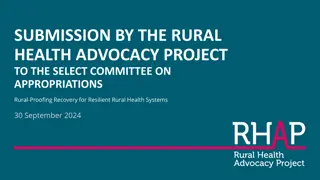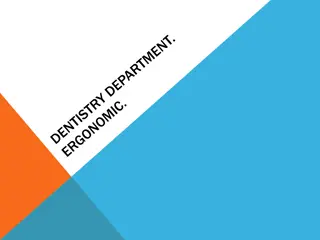Overview of Rural Health Clinics (RHCs) Program
The Rural Health Clinic Services Act of 1977 was signed into law by President Carter to address the lack of access to healthcare in rural America. The program enables Physician Assistants and Nurse Practitioners to offer high-quality care in outpatient clinics. Through regulatory and legislative updates, the RHC program has grown significantly, with over 4400 RHCs in the country. RHCs must meet specific requirements and play a crucial role in providing primary care services in rural and shortage areas.
Download Presentation

Please find below an Image/Link to download the presentation.
The content on the website is provided AS IS for your information and personal use only. It may not be sold, licensed, or shared on other websites without obtaining consent from the author. Download presentation by click this link. If you encounter any issues during the download, it is possible that the publisher has removed the file from their server.
E N D
Presentation Transcript
Fundamentals of Rural Health Clinics (RHCs) Nathan Baugh (202) 543-0348 Nathan.Baugh@narhc.org www.narhc.org
Overview Purpose of RHC Program History of RHC Program Basics of RHCs Regulatory Update Legislative Update
Rural Health Clinic ~ Purpose? President Carter s Statement on December 13, 1977 signing the Rural Health Clinics Services Act into law: At its best the American health care system is unsurpassed. But its uneven distribution leaves millions of our people without access to adequate care. This problem effects both urban and rural areas but is more wide-spread in the latter. Two thirds of the people in areas without adequate health care live in rural America. One of the most sensible and efficient ways to cope with this problem is to enable Physician Assistants and Nurse Practitioners to provide regular and high quality care in small convenient outpatient clinics. Through such programs as the National Health Service Corps and the Appalachian Regional Commission, the federal government has helped to start and support these clinics and train the highly skilled professions who operate them. But there has been a major obstacle to the healthy growth of these clinics in the areas that need them. That is the failure of public and private health insurance programs to support them. The legislation that I am signing today will correct this defect in our public health insurance programs by requiring that the Medicare and Medicaid programs pay for the services of Physician Assistants and Nurse Practitioners in clinics and rural areas without adequate care. This reform will guarantee greater financial stability for clinics already in existence and help establish new clinics were they are needed most.
Rural Health Clinics ~ Brief History & Profile Relatively sleepy program throughout the early 80s. Significant growth in the number of RHCs when hospital payment switched to the prospective payment system (PPS) Turmoil in the late 90s Currently over 4400 RHCs in the country (program is growing) Challenges Remain
RHC Basics ~ Requirements Located in rural areas Located in shortage areas Must undergo a survey and certification process to ensure compliance with 42 Code of Federal Regulations (CFR) Part 491 Must perform primarily primary care services Must employ and utilize a Nurse Practitioner or Physician Assistant at least 50% of the time the RHC is open Can be non-profit or for-profit May be owned by hospital or physicians themselves
RHC Basics ~ Incentives Cost-based reimbursement Medicare All-Inclusive Rate Medicaid PPS Floor ~ Actual payments vary by state but are generally much better than fee for service (FFS) Medicaid payments All-Inclusive Rate = Same Medicare payment no matter what current procedural terminology (CPT) code is billed throughout the course of a year NOT Fee-for-service! Medicare Access and CHIP Reauthorization Act of 2015 (MACRA)/Quality Payment Program (QPP) implications RHCs file cost reports which (theoretically) allows RHCs to receive 100% of the costs of providing care to Medicare patients
RHC Cap ~ Medicare Payment (f) In establishing limits under subsection (a) on payment for rural health clinic services provided by rural health clinics (other than such clinics in hospitals with less (other than such clinics in hospitals with less than 50 beds) than 50 beds), the Secretary shall establish such limit, for services provided (1) in 1988, after March 31, at $46 per visit, and (2) in a subsequent year, at the limit established under this subsection for the previous year increased by the percentage increase in the Medicare economic index (MEI) (as defined in section 1842(i)(3)) applicable to primary care services (as defined in section 1842(i)(4)) furnished as of the first day of that year. The RHC Cap for 2018 was $83.45
2019 Physician Fee Schedule (PFS) Proposed Rule Chronic Care Management (CCM) Provisions Proposed payment methodology for Healthcare Common Procedure Coding System (HCPCS) code G0511 would be the average of the 4 national non- facility PFS payment rates for -CPT 99490 (20 minutes or more of CCM services) -CPT 99487 (60 minutes or more of complex CCM services) -CPT 99484 (20 minutes or more of BHI services) -CPT 99491 (30 minutes or more of CCM furnished by a physician or other qualified health care professional) Proposed payment rate for 99491 is $74.26 Average of the four is around $65
2019 Physician Fee Schedule Communication Technology- Based Services At least 5 minutes of communications technology-based or remote evaluation services Furnished by an RHC practitioner To a patient that has been seen in the RHC within the previous year May be billed when the medical discussion or remote evaluation is for a condition not related to an RHC service provided within the previous 7 days, and Does not lead to an RHC service within the next 24 hours or at the soonest available appointment (since in those situations the services are already paid as part of the RHC all inclusive rate (AIR))
Proposed Billing and Payment for Communication Technology- Based Services New Virtual Communications G code for use by RHCs (and federally qualified healthcare centers (FQHCs)) only G0071 Payment rate set at the average of the PFS national non-facility payment rates for HCPCS code G2012 (communication technology-based services) and HCPCS code G2010 (remote evaluation services) Payment around $14 Many of the details will need to be worked out in final rule and accompanying guidance from Centers for Medicare and Medicaid (CMS)
Legislative Update ~ Senate Finance Hearing https://www.finance.senate.gov/hearings/rural-health-care-in-america-challenges- and-opportunities 2 hour 28 min mark Senator Wyden We have been at it for almost two and a half hours. You all have been terrific, but what I am struck by is I don t think we have mentioned, over the course of two and a half hours, what is really the backbone of rural health care. Literally, from sea-to- shining-sea, and that is RURAL HEALTH CLINICS RURAL HEALTH CLINICS
RHC Modernization Act of 2018 What does it do? Designed to pass, not to make a statement Uncontroversial and cost free provisions Sec. 2 ~ Modernizing Physician, Physician Assistant, and Nurse Practitioner Utilization Requirements. Sec. 2 ~ Modernizing Physician, Physician Assistant, and Nurse Practitioner Utilization Requirements. Modernizes physician supervision requirements in RHCs by aligning scope of practice laws with state law. Allows physician assistants (PAs) and nurse practitioners (NPs) to practice up to the top of their license without unnecessary federal supervision requirements that apply only because the PA or NP is practicing in a RHC. Sec. 3 ~ Removing Outdated Laboratory Requirements Sec. 3 ~ Removing Outdated Laboratory Requirements Removes a requirement that RHCs maintain certain lab equipment on site, and allows RHCs to satisfy this certification requirement if they have prompt access to lab services. Sec. 4 ~ Allowing Rural Health Clinics to Determine the Drugs and Biologicals Necessary for Emergency Cases. Sec. 4 ~ Allowing Rural Health Clinics to Determine the Drugs and Biologicals Necessary for Emergency Cases. Allows the professional personnel responsible for the RHCs policies and procedures, instead of the Secretary of Health and Humans Services, to determine the drugs and biologicals necessary for emergency cases in each specific RHC. Sec. 5 ~ Allowing Rural Health Clinics the Flexibility to Contract with Physician Assistants and Nurse Sec. 5 ~ Allowing Rural Health Clinics the Flexibility to Contract with Physician Assistants and Nurse Practitioners. Practitioners. Removes a redundant requirement that RHCs employ a PA or NP (as evidenced by a W2) and allows RHCs to satisfy the PA, NP, or Certified Nurse Midwife(CNM) utilization requirements through a contractual agreement if they chose to do so.
RHC Modernization Act of 2018 What does it do? Continued Cost Provisions Sec. 6 ~ Raising the Cap on Rural Health Clinic Payments. Sec. 6 ~ Raising the Cap on Rural Health Clinic Payments. Increases the upper limit (or cap) on RHC reimbursement to: -$100 in 2019 -$105 in 2020 -$110 in 2021 -$115 in 2022 -And by MEI each year thereafter. Sec. 7 ~ Allowing Rural Health Clinics to be the Distant Site for a Telehealth Visit. Sec. 7 ~ Allowing Rural Health Clinics to be the Distant Site for a Telehealth Visit. Allows RHCs to offer telehealth services as the distant site (where the provider is located) and bill for such telehealth services as RHC visits.
Contact Information Nathan Baugh (202) 543-0348 Nathan.Baugh@narhc.org www.narhc.org







